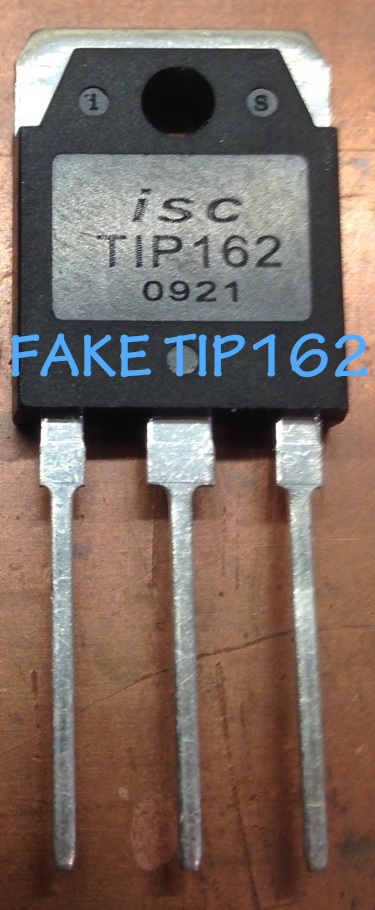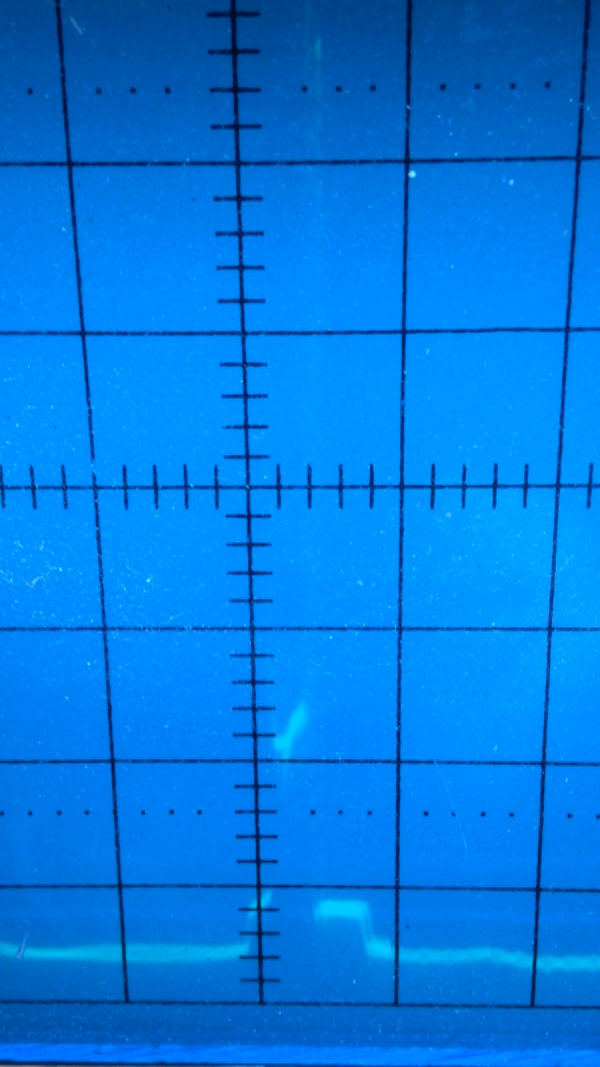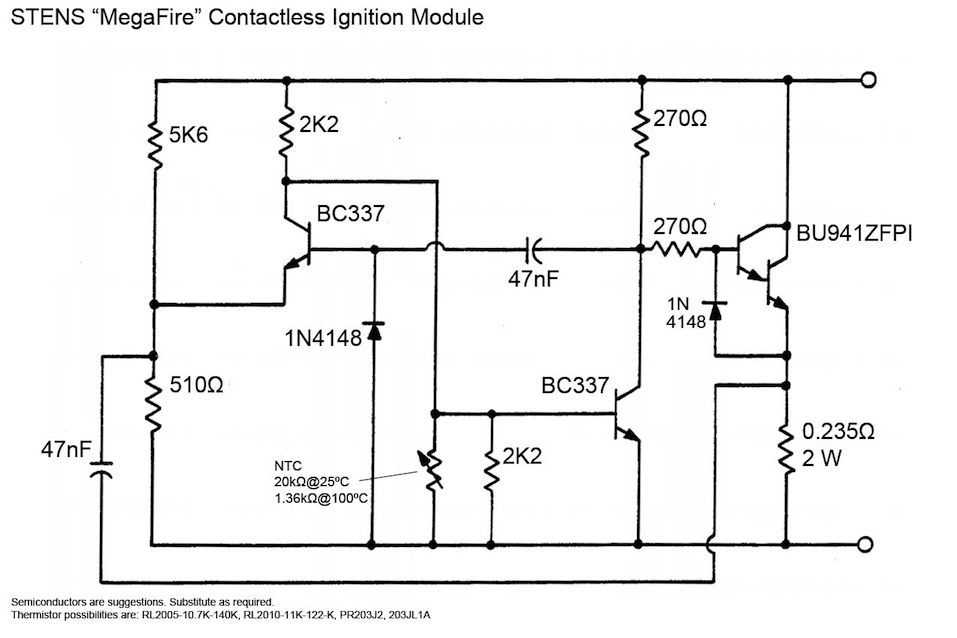Home › Forum › Ask A Member › Testing timing of Red Atom Modules
- This topic has 35 replies, 9 voices, and was last updated 5 years, 6 months ago by
oldfogeyuk.
-
AuthorPosts
-
September 29, 2018 at 8:15 pm #83704
That’s a pretty good summary of the issues Bill.
The one thing I’ve been struggling with is trying to accurately model the R2/R3|C1 behaviour. The ‘standard’ model for capacitive reactance works fine for sinusoids, but in this application the applied voltage is an inconsistent ramp, so calculating suitable values for R2 R3 & C1 beforehand was never going to be simple.
I resorted to experiment rather than planned design primarily because I wanted to explore the limits of capability of the ‘Atom’ design and whether it could be tailored to suit this engine.
The last lot of figures I got allowed me to work out dv/dt close to the switching point at each of the extremes, so I could feed that into a spreadsheet to come up with an idea of the parallel reactance of C1 and its effect, and it just confirmed what I found and what you’ve just explained: Contrary to the simple explanation in the patent, the ignition advance actually reduces with increasing speed.I also had a go at making a ‘Red’ Module, but I can’t get the engine to run with it. I’m a bit worried about the newly acquired batch of TIP162s, they might be dodgy, as in not actually TIP162s at all. More work to follow. (UPDATE: they’re all fake, local supplier is replacing them from another source. A bit of dig on the web suggests there’s a massive flood of fake transistors from guess who? clue: the man in charge of the forty thieves.)
Most recently I tried out one of the Nova II modules for comparison. It provides 18 degrees advance at all speeds. Notably though, it has to be connected with reverse polarity to work. The terminal with the + on it needs to go to chassis. Given that we know the internals of the ‘Atom’ and which terminal is actually positive, the Nova II markings make no sense. I wonder if this is a fake too?
I also stripped down the magneto and flywheel on my engine and measured the angles w.r.t TDC. Guess what: The magneto armature is inclined perpendicular to 22 degrees BTDC, and the magnets in the flywheel are 23 degrees BTDC (This is a dual magnet, single armature type magneto). So, the earlier tests confirm that you can push the module advance right to the extreme point of changeover of the magnetic moment in the magneto.
Still no luck with a decent scope trace, all my photos show overlaid double traces, but I’ve made some progress. It seems my best chance is to shoot a movie of the trace on my ‘phone and then work through each frame to locate a good shot, this has worked on a couple of frames but they’re at the wrong timebase and voltage to provide decent measurements. Also I might need to do it at night to remove the reflection too.
More to come….
September 29, 2018 at 9:05 pm #83708My Scope is a kit DIY DSO138 which I had to assemble. I just freeze frame it & then take pictures. The only thing is its only single trace. Be nice to afford a dual trace Digital scope. I also have had dodgy 2SD1071 transistors first batch of 20 were good then the next were poor performers.
October 2, 2018 at 7:47 pm #83890It’d be nice to have a digital ‘scope with freeze frame. Mine’s an old Gould OS250B dual-trace analogue that I picked up when the technical college auctioned them all off in the nineties. I got it for a fiver ’cause the casing was held together with tape. Enough of that, this is the AOMCI not pimp-my-scope.
Well, I got the replacement TIP162s and tested them and they’re all good, so I rigged a module with a leaf spring terminal block so I could test them with the engine by switching back to contacts and then change transistors and then switch over to the module.
There is a certain amount of variation between them that affects timing, in one case quite a lot. We would have expected that the hfe would not really have much of an effect because this circuit is basically a cascade switch with positive feedback, but it might be the inefficiency when turning on that’s the issue.
It’s led me to realise that I need to make some allowance for variation or select transistors specifically for the most consistent performance.
For those who choose to go down the same path as me, I’ve attached a pic of the dodgy TIP162. Next step is to try some BU941ZPFI transistors, they’e cheaper and more readily available.Scope trace:
I’ve attached a shot from that earlier run where I couldn’t get a proper trigger so there are two cycles overlaid. What’s visible in some of shots from that run is a spike of 30 to 50 volts toward the tail end of the switch off. The vertical axis is 5V/div.
I was working toward getting some better traces by improving the trigger using a coil in the proximity of the ignition lead to pick up a trigger pulse. I was managing the timebase and engine speed to try and get two sparks across the trace, and then expand it to enlarge the area of interest. I was nearly there when I ran out of fuel. It was time for dinner anyway.October 5, 2018 at 9:46 pm #84042Dear OldFogeyUK:
You say the Nova II unit has a fixed timing of 18 degrees (and does not drift with the speed of the motor)?
Isn’t that EXACTLY what you are looking for?Do you have a schematic of the Nova II?
———————
I’m surprised you are trying to figure the capacitive reactance….as the frequencies involved are way too
low to consider that. Simple R-C timing delay is all you need worry about.—————-
Also, in the last issue of the Antique Outboarder, there is my initial writeup on how magnetos work.
However, the ATOM is NOT anything like a set of points! Real points completely short out all voltage
when they are closed (creating maximum current in the primary of the spark coil). The power darlington in
the ATOM modules, in contrast, has about 2 to 2.5 volts of drop across it when "closed"……Whether you are using points or an ATOM unit, when the "points" open up, the current in the primary of
the coil is interrupted, causing an "inductive kick" (which you see as a spike of 30 to 50 volts). In most magnetos,
you’ll see a 100 to 200 volt spike (damped down by the condenser…..otherwise, the voltage would jump to several thousand
volts, causing arcing across the points, and the points would quickly "burn" as a result. That’s what your condenser
is for in traditional Magneto setups.)Those power darlingtons waste a LOT of energy……..but if they didn’t (that is, if they really shorted out
the voltage completely like points do when they are closed)….there wouldn’t be any voltage to turn the power
darlington OFF when you want to "open the points up". This 2 to 2.5 volt drop across the power darlington wastes
a lot of power, lowering the energy that can be converted into spark. You don’t get anywhere near the spark
as you do with points, and you need to pull at higher RPM for spark to start with the ATOM, compared to actual
points.Anyhow…….OldFogeyUK…..what is your goal? It sounds like the NOVA II units give you fixed timing, isn’t that
what you want? Or, is the goal to design a ATOM replacement from scratch, that has exactly some specific characteristics
that you need. What is your goal here?–Bill
***********************************************************************
Bill Mohat MS/CIS, BSEET, CCNA"You can avoid reality, but you cannot avoid the consequences of avoiding reality." --Ayn Rand **********************************************
October 12, 2018 at 1:20 am #84314Sorry I don’t have a circuit specifcally for the Nova II, but I believe it’s a clone of the STENS MegaFire. There’s a circuit for that out in The Aether.
Fixed timing isn’t what I want, It’s what I’ve got with points, and it’s not ideal. I’ve been working to optimise the performance of this little old engine for two reasons: power, and economy/reduce emissions. I reckon if it’s pushing more water at the same throttle setting when I advance the timing from it’s current position, then it must be more efficient. As a result I can reduce the throttle and save fuel and reduce emissions.
I’ve already got a hghly polished set of points, correctly gapped, and a good condenser. No issues with that from an electrical point of view.
However, the timing is fixed. I started experimenting with the modules for the specific purpose of trying to gain some control over the timing, and that’s been quite enightening. The reason I need adjustable timing is to be able to advance it more at full throttle, and bring it back for a steady idle. As I’ve previously explained, I can’t get more advanced than 23 degrees without physically moving the magneto coil, but that’s a significant improvement on the static 15 degrees. I have read that the norm for a two stroke motorcycle is 30 degrees. Having discovered that the modules actually work the opposite way to what they were thought to, I’m considering using that to try to make them work "the right way" which means altering the circuit so that the timing actually advances with increasing speed, that’s why I tried out small inductors in series with R3. I’ll persist for while and report back what I come up with.
Big thanks to DB for the effort he’s put in too. I only we could find somebody with Green PInk and Purple modules to butcher we could have values for the full set.October 14, 2018 at 8:43 am #84393 -
AuthorPosts
- You must be logged in to reply to this topic.




